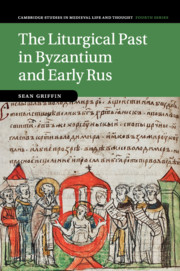Book contents
- The Liturgical Past in Byzantium and Early Rus
- Cambridge Studies in Medieval Life and Thought Fourth Series
- The Liturgical Past in Byzantium and Early Rus
- Copyright page
- Contents
- Acknowledgements
- Abbreviations
- Introduction
- Chapter 1 Liturgy and History in Early Rus
- Chapter 2 The Rus Primary Chronicle
- Chapter 3 Vespers at the Kiev Monastery of the Caves
- Chapter 4 The Dayspring Before the Sun:
- Chapter 5 A New Constantine in the North:
- Chapter 6 A RATIONAL SACRIFICE:
- Conclusion:
- Bibliography
- Index
Chapter 3 - Vespers at the Kiev Monastery of the Caves
Published online by Cambridge University Press: 09 August 2019
- The Liturgical Past in Byzantium and Early Rus
- Cambridge Studies in Medieval Life and Thought Fourth Series
- The Liturgical Past in Byzantium and Early Rus
- Copyright page
- Contents
- Acknowledgements
- Abbreviations
- Introduction
- Chapter 1 Liturgy and History in Early Rus
- Chapter 2 The Rus Primary Chronicle
- Chapter 3 Vespers at the Kiev Monastery of the Caves
- Chapter 4 The Dayspring Before the Sun:
- Chapter 5 A New Constantine in the North:
- Chapter 6 A RATIONAL SACRIFICE:
- Conclusion:
- Bibliography
- Index
Summary
Chapter 3 follows a clerical chronicler through a typical service at the twelfth-century Monastery of the Caves in Kiev, from the moment he hears the call to prayer to the priest’s final blessing from the ambo. Over the course of the narrative, I name and describe every church book that the chronicler takes up in his hands, and every sort of hymn, prayer, and reading that leaves his lips. In so doing, I attempt to provide a modern academic audience with a glimpse into how the liturgy was lived and experienced, day after day, by the men responsible for writing history in early Rus. I further argue that church books were not simply texts or sources like any other. I suggest, rather, they are the surviving artefacts of a Roman storytelling technology that enveloped its participants in a very special kind of narrative world. In my view, the worship of God, and the ritual retelling of his saving acts, was also a covert form of Byzantine political indoctrination. The liturgical rites inculcated an explicitly eastern Roman social arrangement between ruler and ruled, and they embedded this construct in a series of sacred narratives about the conversion and salvation of the Byzantine Empire.
Keywords
- Type
- Chapter
- Information
- The Liturgical Past in Byzantium and Early Rus , pp. 62 - 92Publisher: Cambridge University PressPrint publication year: 2019

